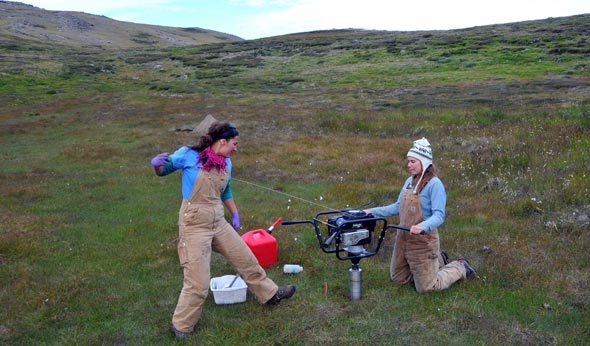Can a girl wear her Manolo Blahnik heels in the field? Is being a scientist like, really a fun job, and can you meet good-looking guys?

These are among the weightier questions alluded to in a one-minute video called Science: It’s a Girl Thing! Showing scenes of sexy babes in short skirts and spike heels interspersed with scenes of a James Bond-look-alike “real scientist,” the video was posted on a European Commission website this summer, met with a collective icy stare, and quickly taken down.
The unfortunate video was part of a well-intentioned E.C. campaign to interest girls and young women in the STEM fields of science, technology, engineering, and mathematics, and was posted on an otherwise commendable website. However, as one commentator noted in the New Statesman, “this kind of campaign insults women who are interested in science already and can more than hold their own with the boys.”
But who says a bad idea can’t lead to a good one? Science in Greenland: It’s a Girl Thing, a video created by a group of Dartmouth women graduate students who did field work in Greenland this past summer, is, well, a bit more to the point.
The new video, says Dartmouth President Carol L. Folt, is everything the first one could have been.
“Science in Greenland is lots of fun,” says Folt, an environmental scientist who is The Dartmouth Professor of Biological Sciences. “It focuses on the talent and commitment of Dartmouth’s scientists, and communicates a passion for scientific research to girls and young women who are considering a career in science.”
As the students, all Cohort 3 fellows in the IGERT program in polar environmental change, explain on their blog, “The discussion in Greenland amongst Cohort 3 about the video and the role of women in science inspired us to make our own version of Science: It’s a Girl Thing!”
The result is a one-minute, 35-second video showing stunning scenes of Greenland and a group of serious scientists hard at work. It is both a tongue-in-cheek response to the European Commission video and a lively and compelling look at scientists working in the field. It should do very well what the E.C. video was meant to do: interest more young people in getting involved in the sciences.
Says IGERT fellow Lee Corbett: “We discussed our reactions to it and thought about what it means to us to be women working in science, and in particular what it means to us to be working in Greenland, and we wanted to make a more faithful portrayal of that.”
Of course, there are a few light-hearted moments. Scientists have a sense of humor, after all, and they clearly enjoy what they do.
“If you want to get young women interested in science, show them science,” says Ross Virginia, the Myers Family Professor of Environmental Science and director of the IGERT program. “They’re in these amazing field environments, doing the work together, collaborating. That’s what attracts these women to science, and they want to share that.”
The video was shot by Courtney Hammond ’11, an IGERT research assistant and videographer; Julia Bradley-Cook, a PhD student and IGERT researcher who works in Greenland every summer, helped create the video. The Greenland Field Seminar is one of the defining pieces of IGERT (Integrative Graduate Education and Research Traineeship), a program of the Dickey Center’s Institute of Arctic Studies.
“We’re really proud and excited that we can go to these amazing places,” says Corbett, “and we’re proud that we can show what we do, and that we can share that with other women who are interested in pursuing a career in science.”
